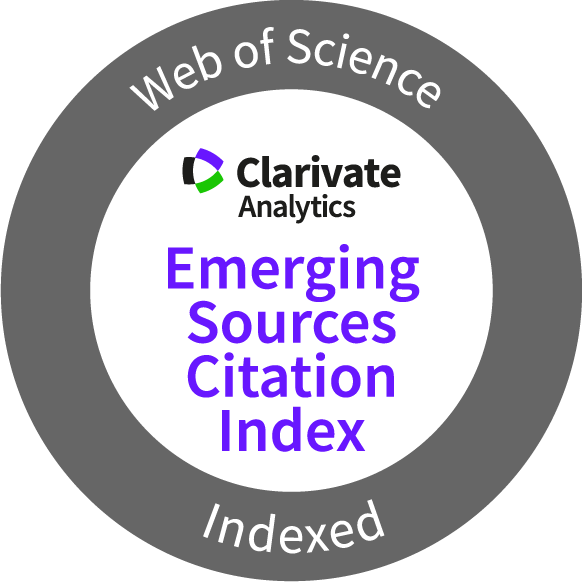Chemistry Journal of Moldova
Natural product chemistry and synthesis
Author(s):
Field: Natural product chemistry and synthesis
Type: Research paper
Issue: 2021 Volume 16, no.2
Pages: 83-90
Alexandru Ciocarlan, Lucian Lupascu, Aculina Aricu, Ion Dragalin, Nina Ciocarlan, Inga Zinicovscaia, Valerina Slanina, Nikita Yushin
Field: Natural product chemistry and synthesis
Type: Research paper
Issue: 2021 Volume 16, no.2
Pages: 83-90
Full Text (PDF): Download
Abstract (PDF)
Graphical Abstract: The GC-MS analysis of the essential oil from Tanacetum corymbosum revealed the presence of 38 compounds, including terpenes - germacrene D, (Z)-β-farnesene, g-elemene, β-caryophyllene, aliphatic - palmitic and linoleic fatty acids, fatty alcohol n-octadecanol, higher alkane n-heneicosane as the major constituents. The in vitro antimicrobial assessment of the ethanolic extract showed promising antibacterial/antifungal activities against five Gram-(+), Gram-(-) and phytopathogenic bacteria species and two fungi strains. The data obtained in this study may be useful both for researchers and for producers interested in new or less studied species of medicinal plants in healthcare and their biological activities.
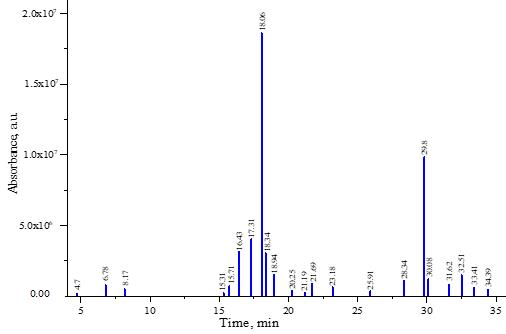
Graphical Abstract: The GC-MS analysis of the essential oil from Tanacetum corymbosum revealed the presence of 38 compounds, including terpenes - germacrene D, (Z)-β-farnesene, g-elemene, β-caryophyllene, aliphatic - palmitic and linoleic fatty acids, fatty alcohol n-octadecanol, higher alkane n-heneicosane as the major constituents. The in vitro antimicrobial assessment of the ethanolic extract showed promising antibacterial/antifungal activities against five Gram-(+), Gram-(-) and phytopathogenic bacteria species and two fungi strains. The data obtained in this study may be useful both for researchers and for producers interested in new or less studied species of medicinal plants in healthcare and their biological activities.
Downloads: 152
Author(s):
Field: Natural product chemistry and synthesis
Type: Research paper
Issue: 2021 Volume 16, no.2
Pages: 76-82
Nina Djapic
Field: Natural product chemistry and synthesis
Type: Research paper
Issue: 2021 Volume 16, no.2
Pages: 76-82
Full Text (PDF): Download
Graphical Abstract: The study described the isolation of β-D-galactopyranoside seco-phytoporphyrin from Atropa belladonna and Solanum tuberosum yellow leaves. Column chromatography was applied for its isolation. The UV-Vis, mass spectrometry and NMR spectroscopy were used for the structure confirmation. The results demonstrate that the two plants that the same chlorophyll catabolite structure.

Downloads: 73
Author(s):
Field: Natural product chemistry and synthesis
Type: Short communication
Issue: 2021 Volume 16, no.2
Pages: 112-116
Wan Mohd Nuzul Hakimi Wan Salleh, Muhammad Helmi Nadri, Shamsul Khamis
Field: Natural product chemistry and synthesis
Type: Short communication
Issue: 2021 Volume 16, no.2
Pages: 112-116
Full Text (PDF): Download
Abstract (PDF)
Graphical Abstract: This study was aimed to investigate the chemica l compositions and lipoxygenase inhibitory activity of the essential oil from Alstonia angustiloba growing in Malaysia. The essential oils were obtained by hydrodistillation and fully characterized by gas chromatography and gas chromatography-mass spectrometry. Analysis of the A. angustiloba essential oil resulted in the identification of twenty-five chemical components, attributed 90.8% of the total oil. The most abundant components of A. angustiloba oil were linalool (21.2%), 1,8-cineole (16.8%), α-terpineol (9.5%), terpinene-4-ol (8.5%), β-caryophyllene (6.2%), and caryophyllene oxide (5.2%). The essential oil displayed moderate activity towards lipoxygenase activity with IC50 value of 45.8 μg/mL.
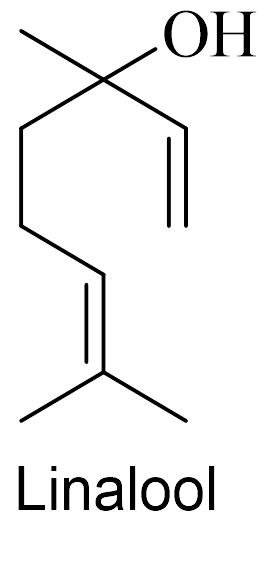
Graphical Abstract: This study was aimed to investigate the chemica l compositions and lipoxygenase inhibitory activity of the essential oil from Alstonia angustiloba growing in Malaysia. The essential oils were obtained by hydrodistillation and fully characterized by gas chromatography and gas chromatography-mass spectrometry. Analysis of the A. angustiloba essential oil resulted in the identification of twenty-five chemical components, attributed 90.8% of the total oil. The most abundant components of A. angustiloba oil were linalool (21.2%), 1,8-cineole (16.8%), α-terpineol (9.5%), terpinene-4-ol (8.5%), β-caryophyllene (6.2%), and caryophyllene oxide (5.2%). The essential oil displayed moderate activity towards lipoxygenase activity with IC50 value of 45.8 μg/mL.
Downloads: 90
Author(s):
Field: Natural product chemistry and synthesis
Type: Invited paper
Issue: 2021 Volume 16, no.1
Pages: 8-29
Aculina Aricu
Field: Natural product chemistry and synthesis
Type: Invited paper
Issue: 2021 Volume 16, no.1
Pages: 8-29
Full Text (PDF): Download
Abstract (PDF)
Graphical Abstract: The purpose of this paper is to put forward concisely some of the most valuable scientific contributions of academician Pavel Vlad and his disciples to the field of natural product chemistry of terpenoids. Under the guidance and with direct contribution of academician Pavel Vlad, new approaches to determining the absolute configuration of a series of labdanic diterpenoids and of converting them into bi-, tri- and tetra- cyclic compounds have been designed. Novel universal methods for synthesizing tetrahydrofurans from 1,4-glycols, olefins from tertiary alcoholic acetates, as well as dienones by means of photodehydrogenation of unsaturated cyclic ketons have been developed by academician Pavel Vlad.
Graphical Abstract: The purpose of this paper is to put forward concisely some of the most valuable scientific contributions of academician Pavel Vlad and his disciples to the field of natural product chemistry of terpenoids. Under the guidance and with direct contribution of academician Pavel Vlad, new approaches to determining the absolute configuration of a series of labdanic diterpenoids and of converting them into bi-, tri- and tetra- cyclic compounds have been designed. Novel universal methods for synthesizing tetrahydrofurans from 1,4-glycols, olefins from tertiary alcoholic acetates, as well as dienones by means of photodehydrogenation of unsaturated cyclic ketons have been developed by academician Pavel Vlad.
Downloads: 270
Author(s):
Field: Natural product chemistry and synthesis
Type: Research paper
Issue: 2021 Volume 16, no.1
Pages: 105-114
Roman Ivannikov, Iryna Laguta, Viktor Anishchenko, Iryna Skorochod, Pavlo Kuzema, Oksana Stavinskaya, Ivan Parnikoza, Oksana Poronnik, Ganna Myryuta, Viktor Kunakh
Field: Natural product chemistry and synthesis
Type: Research paper
Issue: 2021 Volume 16, no.1
Pages: 105-114
Full Text (PDF): Download
Graphical Abstract: The work was aimed at studying the phytochemicals available in D. antarctica plants from various sites on Antarctic Islands, introducing the plants into in vitro culture and comparing the extracts from the plants grown in situ and in vitro. All the extracts were found to contain high amount of phenols, with luteolin and hydroxybenzoic acids derivatives being the main phytochemicals in the extracts from the plants grown in situ and in vitro. Being diluted by 10 times, the extracts scavenged 50÷90% of DPPH• radicals, 20÷40% of NO• radicals and 40÷60% of OH• radicals. Despite the differences in composition, extracts from the plants grown in situ and in vitro showed similar radical scavenging activity.
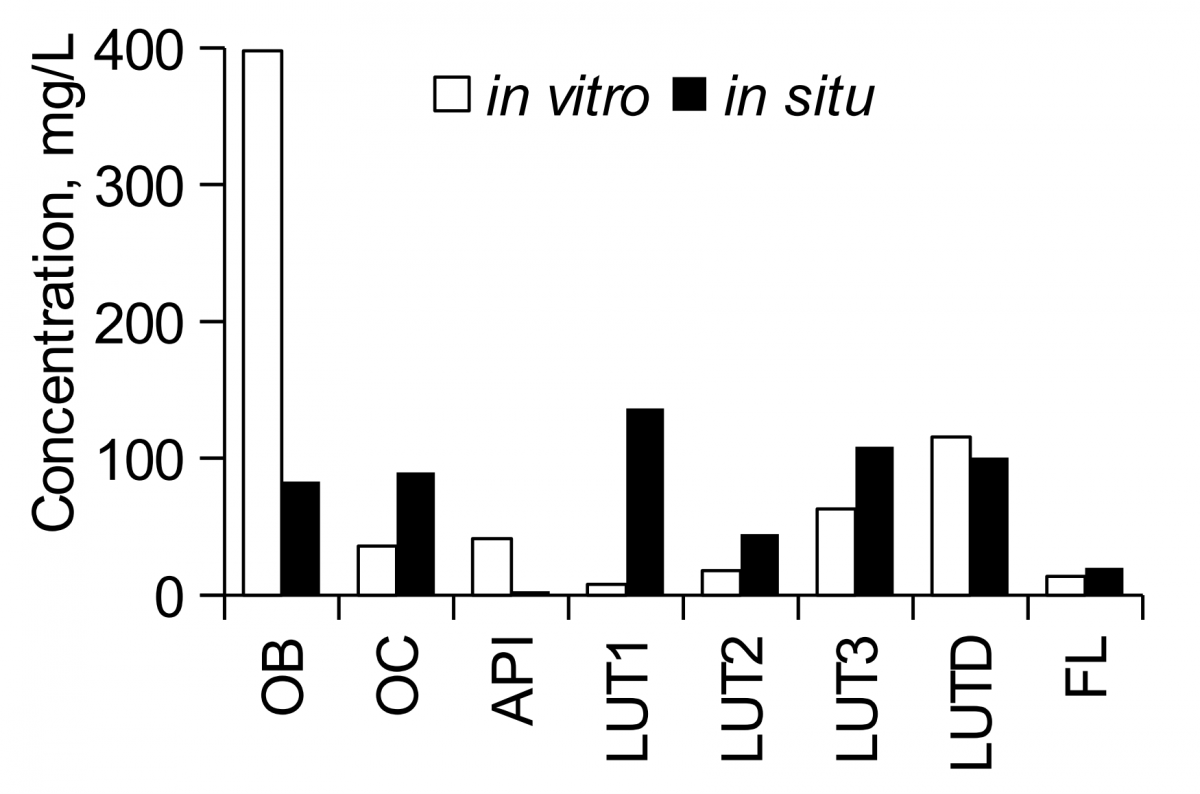
Downloads: 289
Author(s):
Field: Natural product chemistry and synthesis
Type: Review
Issue: 2021 Volume 16, no.1
Pages: 30-45
Alexandru Ciocarlan
Field: Natural product chemistry and synthesis
Type: Review
Issue: 2021 Volume 16, no.1
Pages: 30-45
Full Text (PDF): Download
Abstract (PDF)
Graphical Abstract: (+)-Larixol is a well-known labdane-type diterpenoid widely used in organic synthesis. The present review covers the (+)-larixol based chemical transformations, the results of phytochemical analysis of new (+)-larixol containing species, as well as recent data on biological activity of (+)-larixol and practical applications where it is mentioned.
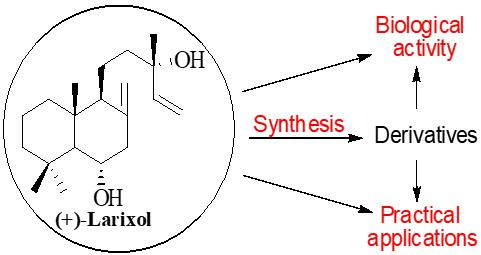
Graphical Abstract: (+)-Larixol is a well-known labdane-type diterpenoid widely used in organic synthesis. The present review covers the (+)-larixol based chemical transformations, the results of phytochemical analysis of new (+)-larixol containing species, as well as recent data on biological activity of (+)-larixol and practical applications where it is mentioned.
Downloads: 205
Author(s):
Field: Natural product chemistry and synthesis
Type: Research paper
Issue: 2021 Volume 16, no.1
Pages: 99-104
Olga Morarescu, Marionela Traistari, Alic Barba, Gheorghe Duca, Nicon Ungur, Veaceslav Kulcițki
Field: Natural product chemistry and synthesis
Type: Research paper
Issue: 2021 Volume 16, no.1
Pages: 99-104
Full Text (PDF): Download
Graphical Abstract: The selective one-step synthesis of 13-epi-manoyl oxide is reported based on a low-temperature superacidic cyclization of sclareol. The reaction conditions have been finely tuned in order to achieve a 9:1 ratio between epimeric oxides in favor of the desired 13-epi-oxide.
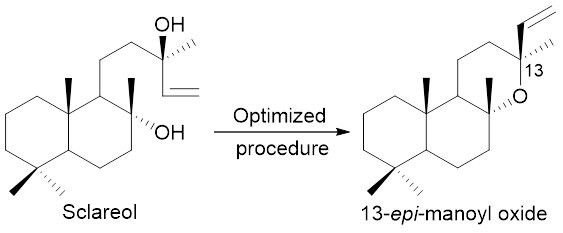
Downloads: 160
Author(s):
Field: Natural product chemistry and synthesis
Type: Research paper
Issue: 2020 Volume 15, no.2
Pages: 78-87
Brahim Ben Aicha, Rachid Rouabhi, Salim Gasmi, Chawki Bensouici, Hichem Mohammedi, Imad Mennai
Field: Natural product chemistry and synthesis
Type: Research paper
Issue: 2020 Volume 15, no.2
Pages: 78-87
Full Text (PDF): Download
Graphical Abstract: The present work focuses on evaluation of the chemical composition and antioxidant activity of the hydro-methanolic extract of Melissa officinalis from Algeria. The liquid chromatography-mass spectrometry analysis allowed the identification of six compounds: caffeic acid, caftaric acid, hydroxyjasmonic acid glucoside, caftaric acid glucoside, rosmarinic acid and sagerinic acid. The in-vitro antioxidant activity of the hydro-methanolic extract was evaluated by using four different methods including: radical scavenging assay (DPPH), scavenging activity (ABTS), cupric reducing antioxidant capacity, and ferric reducing power assay. The extract exhibited a relatively strong antioxidant activity compared to the synthetic antioxidants. The highest radical scavenging activity was registered using DPPH and ABTS methods, IC50= 20.53±2.64 μg/mL and 22.50±0.67 μg/mL, respectively. These results suggest that Melissa officinalis L. could be considered a potential source of natural antioxidants with potential interest in the agrochemical and pharmaceutical industries.


Downloads: 260
Author(s):
Field: Natural product chemistry and synthesis
Type: Research paper
Issue: 2020 Volume 15, no.2
Pages: 69-77
Alexandru Ciocarlan, Lidia Lungu, Svetlana Blaja, Ion Dragalin, Aculina Aricu
Field: Natural product chemistry and synthesis
Type: Research paper
Issue: 2020 Volume 15, no.2
Pages: 69-77
Full Text (PDF): Download
Abstract (PDF)
Graphical Abstract: The present paper reports the results of microwave irradiation assisted method for the preparation of bicyclohomofarnesenic methyl esters versus classical Stoll and Hinder method. Moreover, the chemical transformations of bicyclohomofarnesenic methyl esters via anodic electrooxidation and dye-sensitized photooxidation were performed. A new method for the preparation of methyl 7-oxo-13,14,15,16-tetranorlabd-6,8(8)-dien-12-oate and the mechanism of electrochemical products formation are presented. The structure of all synthesized compounds was fully confirmed by spectral methods.
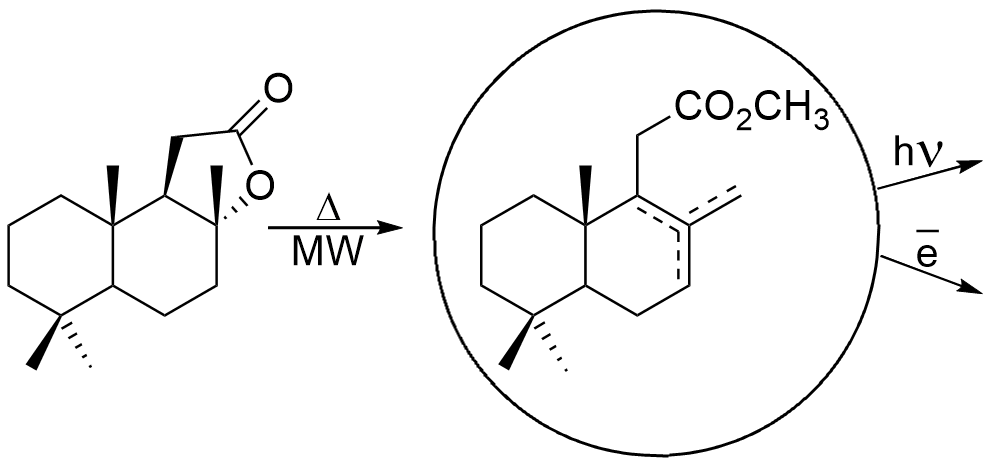
Downloads: 219
Author(s):
Field: Natural product chemistry and synthesis
Type: Research paper
Issue: 2019 Volume 14, no.2
Pages: 79-89
Hichem Mohammedi, Samira Idjeri-Mecherara, Fouad Menaceur, Aicha Hassani
Field: Natural product chemistry and synthesis
Type: Research paper
Issue: 2019 Volume 14, no.2
Pages: 79-89
Full Text (PDF): Download
Abstract (PDF)
Graphical Abstract: This paper focuses on the study of the effect of extraction solvent choice on phenolic compounds contents and antioxidant activity of Bassia muricata. In this study, five different solvents namely: water, acetone, ethanol, methanol and hexane, and three extraction techniques were used to extract phenolic compounds: microwave-assisted extraction, Soxhlet and maceration. Total phenolics, total flavonoids and condensed tannins contents were determined. The results showed that different solvents with different polarity had a major effect on polyphenolic contents and antioxidant activity. Microwave-assisted extraction was the best suited for the extraction of antioxidant molecules when compared to Soxhlet and maceration.
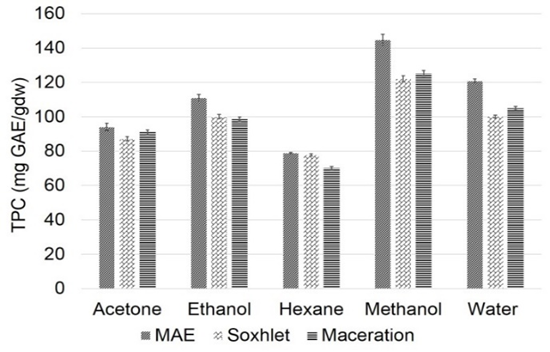
Graphical Abstract: This paper focuses on the study of the effect of extraction solvent choice on phenolic compounds contents and antioxidant activity of Bassia muricata. In this study, five different solvents namely: water, acetone, ethanol, methanol and hexane, and three extraction techniques were used to extract phenolic compounds: microwave-assisted extraction, Soxhlet and maceration. Total phenolics, total flavonoids and condensed tannins contents were determined. The results showed that different solvents with different polarity had a major effect on polyphenolic contents and antioxidant activity. Microwave-assisted extraction was the best suited for the extraction of antioxidant molecules when compared to Soxhlet and maceration.

Downloads: 231


